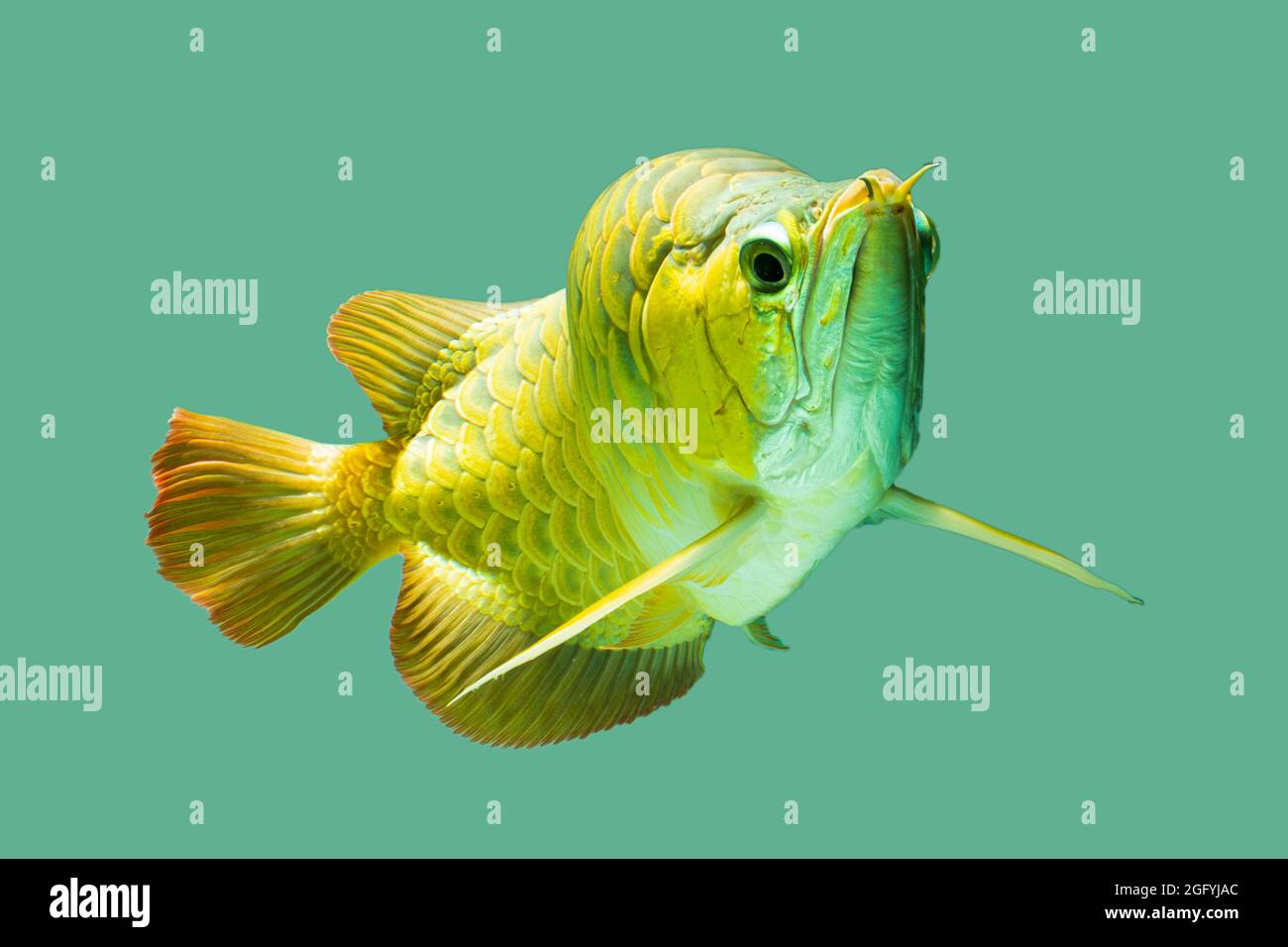Behold the awe-inspiring Asian Arowana, often called the “dragon fish” for reasons that will soon become clear. This stunning creature appears as if it’s leaped straight from the pages of ancient myths. Prepare to delve into the captivating world of the Asian Arowana, exploring its origins, uncovering the reasons behind its illegal status in certain regions, unveiling its rarest color variations, and examining the ongoing conservation efforts aiming to safeguard these magnificent creatures within their natural habitats.
Why is the Asian Arowana Called the “Dragon Fish”?
The Asian Arowana, native to the rivers and lakes of Southeast Asia, is a sight to behold. But have you ever wondered why it’s often referred to as the “dragon fish?” This nickname isn’t merely a catchy moniker; it speaks volumes about the fish’s striking resemblance to the mythical Chinese dragon.
Imagine: an elongated, sleek body adorned with large, shimmering scales, complemented by whisker-like barbels and flowing fins that evoke an image of a dragon in flight. This remarkable resemblance is no coincidence. In Chinese culture, dragons symbolize power, wealth, and good fortune—qualities that have become associated with the Asian Arowana.
Adding to its mystical aura, the Arowana is known for its impressive ability to leap high out of the water, a behavior reminiscent of a dragon taking flight. This powerful movement further solidifies its connection to the legendary creatures of myth.
The name “dragon fish” embodies the Arowana’s stunning aesthetics, its dynamic movements, and the profound cultural significance it holds in East and Southeast Asia, blurring the lines between myth and reality.
Unraveling the Complexities of the Asian Arowana’s Illegal Status
The awe-inspiring Asian Arowana, with its majestic presence, has become a subject of controversy due to its illegal status in many parts of the world. This complex issue stems from a confluence of factors, including the urgent need for conservation, the respect for deeply rooted cultural beliefs, and the persistent challenges posed by the illegal wildlife trade.
The Asian Arowana, once a thriving inhabitant of Southeast Asian freshwater ecosystems, now faces a dire situation. Habitat destruction, coupled with overfishing driven by its popularity in the aquarium trade, has led to a drastic decline in its population. The International Union for Conservation of Nature (IUCN) has officially classified this species as endangered, highlighting its very real risk of extinction in the wild. To counter this threat, many countries, including the United States, have implemented strict bans on the trade of Asian Arowanas, aiming to curb the demand that fuels their capture from their natural habitats.
However, the story doesn’t end there. This magnificent fish carries immense cultural weight, particularly in some Asian cultures where it is revered as a powerful symbol of prosperity, luck, and good fortune. Rooted in ancient practices like Feng Shui, the demand for Asian Arowanas persists, unfortunately driving a thriving black market trade that further jeopardizes the survival of this already threatened species.
To address this multifaceted issue, some proponents suggest that controlled breeding programs could provide a solution. The idea is to alleviate the strain on wild populations by supplying captive-bred Arowanas, thus satisfying the demand while offering an ethical alternative to wild-caught specimens. However, this approach faces criticism as well, with opponents arguing that it could inadvertently fuel the illegal pet trade and potentially compromise the genetic diversity of wild populations.
The debate surrounding the effectiveness and ethical implications of captive breeding programs continues, reflecting the intricate balance we strive to achieve between human desires and the preservation of our planet’s biodiversity. The plight of the Asian Arowana serves as a stark reminder of the profound responsibility we hold in protecting vulnerable species and ensuring their survival for generations to come.
Unveiling the Rarest Gems: A Guide to the Most Sought-After Asian Arowanas
The Asian Arowana family boasts a spectrum of breathtaking colors and patterns, but within this dazzling array, some rare variations stand out, captivating collectors and enthusiasts alike. These highly sought-after specimens command respect and often fetch astonishing prices, making them the crown jewels of the aquarium world.
Perhaps the most coveted of them all is the platinum arowana. Envision a fish adorned with scales that shimmer with an almost ethereal, white-silver brilliance—a truly mesmerizing sight. The platinum arowana’s rarity has elevated it to near-legendary status among collectors.
Another top contender vying for the title of “most sought-after” is the super red arowana. True to its name, this variety flaunts a vibrant, intense red coloration that seems to emanate from within, captivating all who behold it.
But the world of Arowanas holds more treasures yet. The golden arowana, with its dazzling, metallic scales, and the crossback arowana, distinguished by its unique scale pattern, are also highly prized by collectors. While not as rare as the platinum Arowana, encountering one is an occasion worth celebrating.
These rare Arowanas are more than just aesthetically captivating creatures; they represent a piece of living art, embodying prestige and good fortune in various cultures. Their exorbitant prices, often reaching tens of thousands of dollars, reflect their rarity, beauty, and cultural significance.
Here’s a glimpse into the world of these exceptional Arowanas:
| Arowana Type | Description |
|---|---|
| Platinum | Shimmering, almost white scales |
| Super Red | Deep, vibrant red coloration |
| Golden | Brilliant, metallic gold scales |
| Crossback | Unique scale pattern on the back |
The allure of Asian Arowanas extends beyond their established variations. New color morphs and patterns continue to surface, hinting at the hidden wonders yet to be discovered in the depths. This constant evolution and the potential for encountering new, never-before-seen variations fuel the passion of Arowana enthusiasts worldwide. It is this sense of wonder and the quest for the unknown that makes these fish genuinely captivating.
Don’t miss out on our other captivating aquatic guides! Uncover the fascinating stages of an axolotl’s life from egg to adult in our comprehensive guide: axolotl life cycle. Plus, gain valuable insights into the average axolotl life expectancy, ensuring you provide the best possible care for your aquatic companion.
















